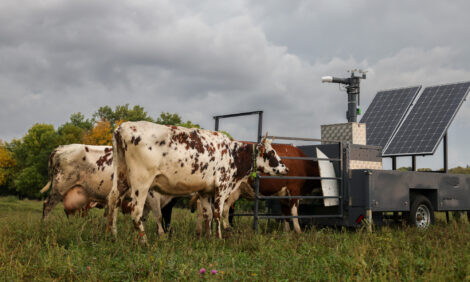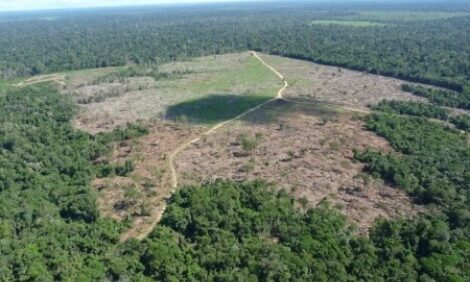



Alfalfa For Grazing
With total season weight gains of over 800lb/acre observed in trials and demonstrations, alfalfa grazing could be a worthwhile way of extending the productive life of your alfalfa hay stands, according to Garry Lacefield, University of Kentucky.High grain prices, increasing nitrogen prices, droughts, need for higher quality pasture plants and improved alfalfa varieties have all contributed to a greater interest in and opportunity for alfalfa as a grazing crop, writes Mr Lacefield, Forage Specialist at Kentucky Extension.
Alfalfa is a high yielding, high quality, deep-rooted, versatile forage legume well adapted throughout the U.S. Gains per animal and per acre can be excellent with acceptable stand persistence when present technology is used. Is grazing alfalfa right for everyone? Only you can answer that question. This presentation attempts to give you information that will hopefully help you with that answer.
Alfalfa is the most important forage legume grown in the United States. Grown over a wide range of soil and climate conditions, it has the highest yield potential and feeding value of all perennial forage legumes. This versatile crop can be used for hay, pasture, silage, green-chop, pellets, cubes and soil improvement. Because of its many merits, especially yield, quality and versatility, it can be used successfully in many animal feeding programs.
Do you need a high-producing pasture plant? With proper grazing management, alfalfa’s high yield potential can be converted to high levels of animal production per acre. Liveweight gains per acre are quite high for grazing beef cattle, with total season gains of 500 to over 800 lb/acre in research trials and on-farm demonstrations. Milk production per acre and per animal can be high when grazing alfalfa.
Do you need a high quality pasture plant? Alfalfa’s quality for grazing is excellent, resulting in total season average daily gains over 2 lb/day in grazing trials and demonstrations.
Do you need pasture legumes that grow well during summer? Alfalfa’s deep root system makes it more drought tolerant than our other cool-season legumes and grasses. Although alfalfa does not make maximum growth during summer droughts, it usually provides good summer pastures. During extreme drought this aspect becomes even more important since cool-season grasses become dormant.
Do you want a versatile pasture plant? Alfalfa can be ideal on farms where it can be used for hay, silage, or grazing. Virginia workers studied systems of grazing alfalfa based on need and environmental conditions. Systems of grazing the early spring growth provided quality feed and delayed the first hay harvest until more favorable weather for curing. Other systems provide grazing during midsummer when cool-season grasses are often less productive. Comparing the systems shows that total season yield as not reduced by any graze-hay systems.
Do you want to extend the productive life of some of your alfalfa hay fields? For old alfalfa fields that have been used for hay but where some of the stand has been lost or become weedy, grazing can extend the stand’s useful life a year or more. Grazing may also rejuvenate some stands by reducing grass and weed competition. Research results – When alfalfa stands decline to less than 3 plants/sq ft, optimum hay yields usually cannot be achieved. Excellent beef gains have been made on alfalfa stands with as few as 1 plant/sq ft although productivity per acre suffers.
Do you want to reduce your machinery cost and lower your fertilizer expenses? Over 40% of the cost of producing alfalfa hay is machinery and equipment. In a total grazing system, this cost can be eliminated or certainly minimized. Under grazing, most of the plant nutrients are returned as dung and urine. Annual fertilizer needs therefore would be lower than where plant nutrients are removed from a field as hay. In addition, alfalfa is our highest nitrogen fixing forage legume (Table 1). As nitrogen prices rise, the factor of “home-grown” nitrogen becomes an even greater factor.
Table 1. Value and Amount of Nitrogen Fixed by Various Legumes.

Is alfalfa right for you? If you answered YES to some of the previous questions, it is at least worthy of your consideration; but wait, let me tell you some of the problems and make a few comments about them.
The most frequent concern of producers considering grazing alfalfa is bloat, but it can be minimized with precautions. Producers may lose more money from the fear of bloat than from bloat itself if it keeps them from efficiently using the alfalfa pasture.
Additional Fencing – Alfalfa must be grazed on a rotational basis. Doing so requires that fields be subdivided so that cattle are restricted to one area for a time, and then moved to another area. This system gives the grazed area time to regrow before grazing again. Fencing does not have to be elaborate or complex. Simple low-cost electric fences that restricts animals to a given area are adequate. Access to water and minerals is also important.
Greater Management and Labor Inputs – Although some consider this category to be a disadvantage, advocates of controlled grazing do not always agree. Once the necessary fencing is in place, time studies have shown that the amount of additional labor required for rotational grazing is quite small compared to harvesting hay. In addition, regularly moving cattle to new pastures lets the producer observe them more closely and therefore permits greater cattle-pasture management efficiency.
Stand Decline – If alfalfa plants are not grazed properly, stands decline. Grazing animals may damage alfalfa crown during wet and muddy conditions. In addition, damage to new crown shoots can occur when cattle are left on an individual paddock after new shoots develop. Grazing tolerant varieties are more tolerant but all have limits and should certainly be rotationally grazed.
Now, Alfalfa Grazing – Is it right for you? Only you can answer that question; however, I hope you will agree that Alfalfa – Queen of the forage Crops based on its merits, its long standing track record throughout the World, its well documented research and demonstration results, and the many satisfied farmers, it is certainly worthy of your consideration.
May 2013


